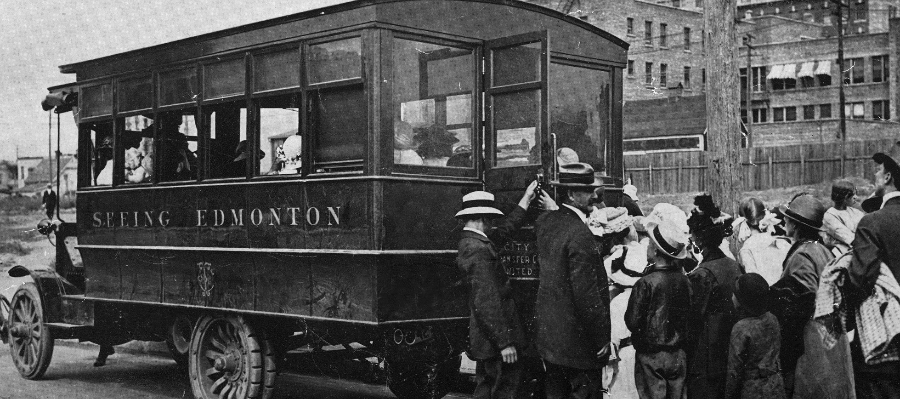
Presented by
Parallèle AlbertaDiscover how Francophones helped develop Edmonton, as well as this city's leading role in Canadian history.
EXPLORE
The interactive map offered on BaladoDiscovery presents several must-see places and gives you access to audio capsules read with passion by dynamic voices.
ON SITE
Use of the BaladoDiscovery mobile app (rather than the website) and use of headphones are recommended. The visit experience is accessible online (streaming) and even offline (without Internet on site, cell phone in hand) with the Preload option of the BaladoDiscovery App.
CONTEXT
In recent years, a new history of Francophones in Alberta has emerged from the mists of the past. It is no longer only the heroic tales of the first pioneers, or the chronicle of the obstacles imposed on the French language and culture that dominate this history. Instead, we discover a more complex story of the interplay of alliances - and misalliances - between many peoples working shoulder to shoulder to build a new life on this vast northwestern plain, or to preserve an endangered ancestral life. This tour experience will introduce you to how the city of Edmonton came to be, as well as its prominent role in the history of this part of the country.
A TRADE CENTER
Fort Edmonton was primarily a fur trade center, an industry on which the Hudson's Bay Company had a monopoly after its merger with the North West Company in 1821. The owners and their representatives spoke English, the First Nations who supplied the pelts spoke a multitude of languages, and a large number of the voyageurs who served as intermediaries were French-speaking, Métis from the Plains and Ontario or other francophones from the east of the country.
ASSIGNED NAMES
The city was known by many names a long time before Europeans came: Amiskwacîwâskahikan (House of the Beaver Hills) for the Cree, It ti oda (Many Houses) for the Nakoda Sioux and Amakowsis, or Omahkoyis (Big Lodge) for the Niitsitapi.
It was the Klondike Gold Rush of 1896 to 1899 that galvanized the city's growth. For prospectors, Edmonton was the last major city before making the long and arduous journey to the Yukon. Hotels, boarding houses and general stores sprang up to meet the demand. The steady stream of immigrants from the Quebec diaspora, Manitoba, Ontario, the United States and Europe fueled this demand in the early twentieth century.
During this period, Francophones were as numerous as Anglophones in the young municipality. They were merchants, lawyers, judges, pioneers and day laborers. Women were prominent in agriculture, education, health care and service industries. The Métis community was important and included large landowners like Laurent Garneau.
As elsewhere in the country, Francophones were recognized by their language and religion. One of the slogans of the Catholic Church at the time linked the two: ‘La langue, gardienne de la foi’ ([French] language, guardian of the faith).
The first churches were built on the north side of the river, since another town, Strathcona, occupied the south side. It was not until 1912 that the two towns merged. The French-speaking notables settled, built houses, buildings, businesses and cemeteries. They partnered up with people from other cultures, other languages.
Catholic religious congregations of women and men also arrived from the East to provide education and health care in French. The Sisters of Charity of Montreal, commonly known as the Grey Nuns, founded the Edmonton General Hospital. The Jesuit College opened in 1913, while the Sisters of the Assumption of the Blessed Virgin opened the Assumption Academy.
In 1911, the Oblates of Mary Immaculate moved their seminary, Collège Saint-Jean, from Pincher Creek to east of Strathcona. It was around this institution that the heart of Francophone life, first settled on the North side of the river, would migrate throughout the twentieth century.
Before becoming a post-secondary institution for all, in the 1960s, St. John's Seminary received male students from all cultures and languages. The city's Francophone community, which established a French radio station in 1949, shared broadcasting hours with other cultural communities, such as Ukrainians and Poles.
In the 1970s and until the end of the 1980s, there was only talk of assimilation and the disappearance of Francophones in Edmonton and Alberta. The opposite has happened: it is this same community that has absorbed into its folds the Francophones from Quebec, Acadie, Europe and Africa, and those lovers of French language and culture we called Francophiles. If there are still battles to be fought to ensure that French-speaking culture flourishes in Edmonton and Alberta, this new cultural mosaic will know how to win them.
Enjoy your experience !
CREDITS
The creators of this self-guided tour would like to thank the following people, companies and associations:
CAVA (Centre d'arts visuels de l'Alberta), Centre 82, La cité francophone, the City of Edmonton, the City of Edmonton Archives, Edmonton Catholic Archdiocese, The French-Canadian Association of Alberta (ACFA), Provincial Archives of Alberta, Saint-Thomas Aquinas Parish, La société des manoirs Saint-Joachim et Saint-Thomas, The University of Alberta - Campus Saint-Jean and Wolf Willow Studios.
A production of Conseil de développement économique de l'Alberta (CDEA).

Comments
Francophone Heritage in Edmonton